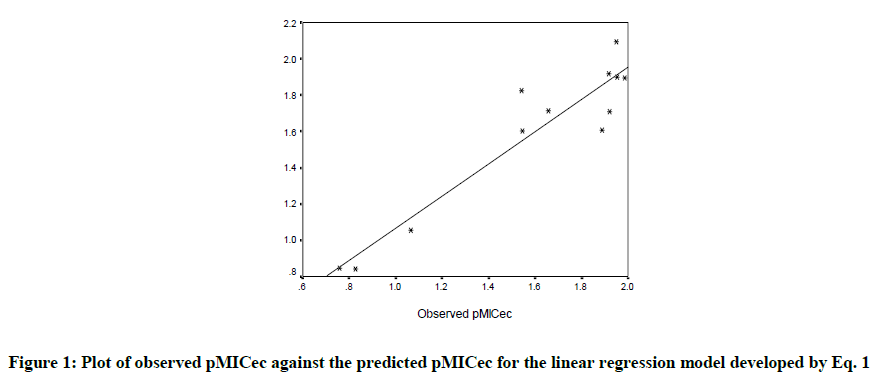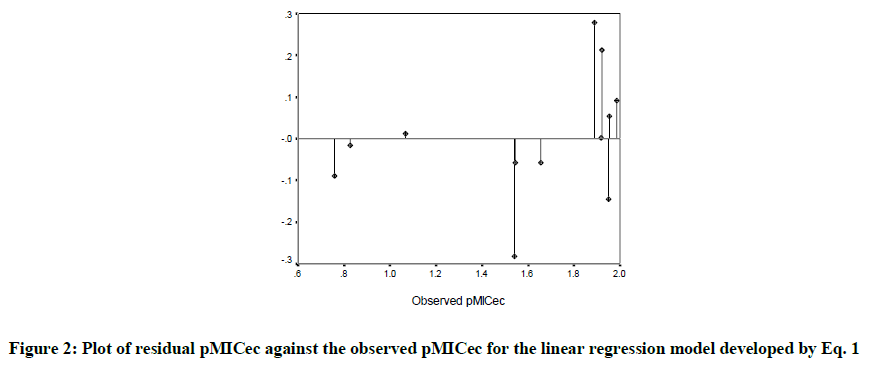Research Article - Der Pharma Chemica ( 2018) Volume 10, Issue 10
QSAR Analysis for Antimicrobial Activity Prediction of Di-(Alkyl/Aryl)-Substituted Tin (IV) Metal Complexes Derived from Schiff Bases of Pyridoxal
Nidhi Malhotra1, Sonika Asija2, Samridhi Thakral3 and Vikramjeet Singh3*
1Department of Chemistry, Hindu Girls College, Sonepat, Haryana, India
2Department of Chemistry, Guru Jambheshwar University of Science and Technology, Hisar-125001, Haryana, India
3Department of Pharmaceutical Sciences, Guru Jambheshwar University of Science and Technology, Hisar-125001, Haryana, India
- *Corresponding Author:
- Vikramjeet Singh
Department of Pharmaceutical Sciences
Guru Jambheshwar University of Science and Technology
Hisar-125001, Haryana, India
Abstract
The present study was undertaken to obtain Quantitative structure activity relationship (QSAR) models for predicting the antimicrobial activity of di-(alkyl/aryl)-substituted Tin (IV) metal complexes derived from Schiff bases of pyridoxal. A data set consisting of 12 di-(alkyl/aryl)-substituted Tin (IV) metal complexes derived from Schiff bases of pyridoxal was subjected to linear free energy regression analysis and QSAR models were obtained for the respective microorganisms. The QSAR analysis revealed that energy of lowest unoccupied molecular orbital (LUMO), valence zero order molecular connectivity index (0χv) and second order molecular connectivity index (2χ) were effectively moderating the antimicrobial activity of di-(alkyl/aryl)-substituted Tin (IV) metal complexes. The derived QSAR models have got excellent predictive power associated with them as evidenced by the low residual values. These models can be utilized for the prediction of antimicrobial activity of similar type of compounds.
Keywords
Antibacterial, Antifungal, Descriptors, Hansh analysis, Linear regression, Validation.
Introduction
The development of multidrug resistance among the microbial strains developed the problem of evolutionary acclimatization of microorganisms which is responsible for lack of effective antimicrobial therapy [1,2]. Therefore, this demands for design, discovery and development of potent antimicrobial agents with broad spectrum of activity with minimal side effects. Quantitative structure activity relationship (QSAR) is a statistically validated tool in computational chemistry which is highly efficacious in elucidating the structural basis for biological activity by correlating the structural descriptors of molecule derived from chemical structures with biological activity [3,4]. QSAR correlates structural and molecular properties called descriptors with experimentally measured quantities like physicochemical properties, biological activities and toxicity for a set of indifferent compounds [5]. Ordinarily, molecular descriptors are preferred in an empirical way, according to their efficiency to give valid results in statistical models. Data collection, selection and procurement of molecular descriptors, correlation model development, and lastly model evaluation are the prime steps which are implicated in this method [6].
We have been continuously associated with studies involving quantitative structure activity relationship using linear regression analysis to come up with mathematical models for prediction of biological activities [7-12], and in continuation of this we have made an effort in the present study, to perform QSAR analysis for prediction of antimicrobial activity of di-(alkyl/aryl)-substituted Tin (IV) metal complexes derived from Schiff bases of pyridoxal reported by Nidhi et al. [13].
Materials and Methods
QSAR analysis
The two dimensional structures were drawn and energy minimization was done by Molecular Mechanics Force Field (MM) process of Hyperchem 6.03 (1993) and also the pre-optimization of the structures of di-(alkyl/aryl)-substituted Tin (IV) metal complexes was done [14]. The semiempirical method PM3 (Parametric Method-3) was undertaken for refining geometries with a gradient norm limit of 0.01 kcal/Å. The calculation of physicochemical parameters for each compound was done by using TSAR 3.3 software for Windows (2000) [15] and the SPSS software package (1999) [16] was employed for regression analysis.
QSAR analysis was carried out between the biological activity and structural descriptors reprsenting for topological, steric and electronic properties of the di-(alkyl/aryl)-substituted Tin (IV) metal complexes derived from Schiff bases of pyridoxal to ascertain the mathematical/quantitative relationship between analogous structures and antimicrobial activity using the linear free energy relationship model (LFER) described by Hansch and Fujita [14]. The negative logarithm of observed antimicrobial activities (i.e. MIC) was calculated which gave the dependent variable pMIC (i.e. –log MIC, Table 1). The diverse structural descriptors like Randic topological index (R), Wiener topological index (W), dipole moment (), Kier’s molecular connectivity (0χ, 0χv, 1χ, 1χv, 2χ, 2χv) and shape (κ1, κ2, κ3) topological indices, Balaban topological index (J), Total energy (Te), electronic energy (Ele.E), energies of highest occupied molecular orbital (HOMO), lowest unoccupied molecular orbital (LUMO) and nuclear repulsion energy (Nu.E) calculated for di-(alkyl/aryl)-substituted Tin (IV) metal complexes derived from Schiff bases of pyridoxal are presented in Table 2 [15-20].
| Comp. | Structure | pMICbs | pMICec | pMICsa | pMICca | pMICan |
|---|---|---|---|---|---|---|
| 1 | 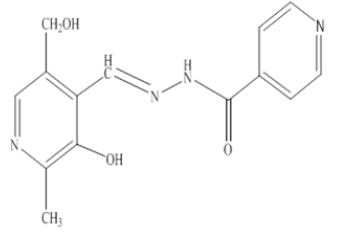 |
1.059 | 0.758 | 1.059 | 1.059 | 0.758 |
| 2 | 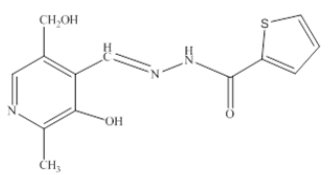 |
1.066 | 1.066 | 0.765 | 1.066 | |
| 3 | 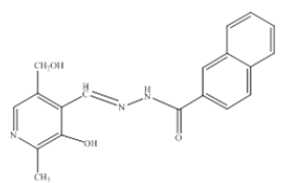 |
1.128 | 0.827 | 0.827 | 1.128 | 0.827 |
| 4 | 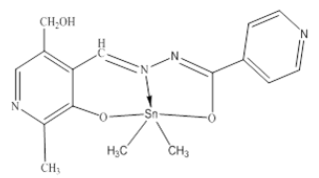 |
1.841 | 1.54 | 1.54 | 1.54 | 1.54 |
| 5 | 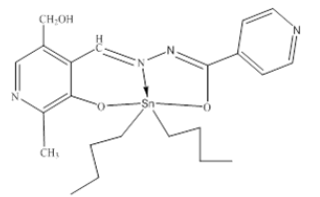 |
1.918 | 1.918 | 1.617 | 1.617 | 1.316 |
| 6 | 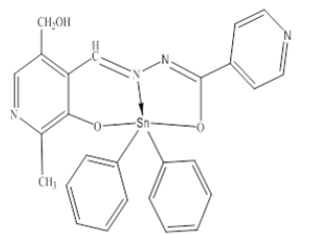 |
1.95 | 1.95 | 2.252 | 2.252 | 1.95 |
| 7 | 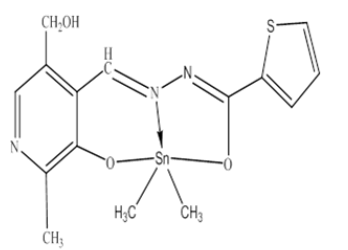 |
1.846 | 1.545 | 1.244 | 1.545 | 1.545 |
| 8 | 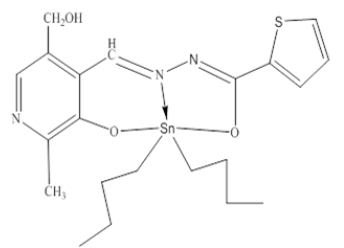 |
1.922 | 1.922 | 1.621 | 1.621 | 1.922 |
| 9 | 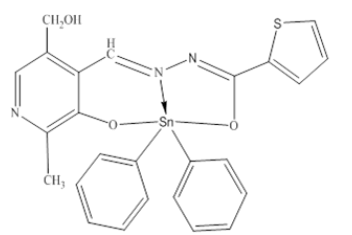 |
2.256 | 1.954 | 1.653 | 2.256 | 2.256 |
| 10 | 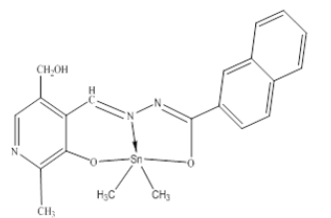 |
1.586 | 1.887 | 1.586 | 1.586 | 1.586 |
| 11 | 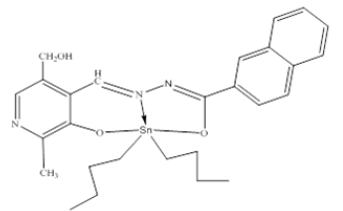 |
2.259 | 1.656 | 1.957 | 1.656 | 1.656 |
| 12 | 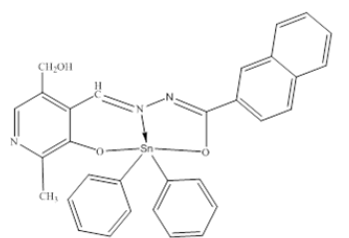 |
2.289 | 1.987 | 1.987 | 2.289 | 2.289 |
Table 1: Antimicrobial activity of di-(alkyl/aryl)-substituted Tin (IV) metal complexes derived from Schiff bases of pyridoxal (μm/ml)
| Comp. | 0χ | 0χv | 1χ | 1χv | 2χ | 2χv | k1 | k2 | k3 | R | Te | Ele.E | LUMO | HOMO | μ |
|---|---|---|---|---|---|---|---|---|---|---|---|---|---|---|---|
| 1 | 15.242 | 11.316 | 10.13 | 6.149 | 8.552 | 4.224 | 17.355 | 8.585 | 4.733 | 10.13 | -3772.28 | -23227.3 | -0.872 | -8.999 | 5.973 |
| 2 | 14.535 | 11.582 | 9.63 | 6.735 | 8.199 | 4.99 | 16.372 | 7.852 | 4.25 | 9.63 | -3617.94 | -21855.3 | -0.996 | -8.814 | 8.376 |
| 3 | 17.811 | 13.6 | 12.097 | 7.704 | 10.532 | 5.55 | 19.753 | 9.274 | 4.838 | 12.097 | -4246.92 | -28875.6 | -0.87 | -8.983 | 5.876 |
| 4 | 16.974 | 16.615 | 11.394 | 17.147 | 11.517 | 20.859 | 17.416 | 6.021 | 2.92 | 11.394 | -4166.4 | -28939.4 | -1.453 | -8.407 | 1.847 |
| 5 | 21.217 | 20.858 | 14.546 | 18.575 | 12.926 | 21.752 | 23.168 | 9.469 | 4.199 | 14.546 | -5101.3 | -42649 | -1.509 | -8.354 | 2.229 |
| 6 | 23.2 | 21.388 | 16.649 | 17.577 | 15.049 | 20.101 | 24.343 | 9.708 | 3.833 | 16.649 | -5500.41 | -46830.5 | -1.615 | -8.478 | 1.749 |
| 7 | 16.267 | 16.881 | 10.894 | 17.733 | 11.163 | 21.625 | 16.468 | 5.5 | 2.616 | 10.894 | -4012.05 | -27444.1 | -1.322 | -8.26 | 4.179 |
| 8 | 20.51 | 21.124 | 14.046 | 19.161 | 12.572 | 22.518 | 22.203 | 8.859 | 3.863 | 14.046 | -4946.95 | -40881 | -1.385 | -8.212 | 4.53 |
| 9 | 22.493 | 21.655 | 16.149 | 18.163 | 14.696 | 20.867 | 23.402 | 9.142 | 3.556 | 16.149 | -5346.06 | -45025.5 | -1.499 | -8.336 | 4.079 |
| 10 | 19.543 | 18.9 | 13.36 | 18.702 | 13.496 | 22.185 | 19.934 | 7.017 | 3.353 | 13.36 | -4640.86 | -34908.3 | -1.325 | -8.269 | 4.357 |
| 11 | 23.786 | 23.142 | 16.512 | 20.13 | 14.905 | 23.078 | 25.641 | 10.401 | 4.608 | 16.512 | -5575.76 | -49579.3 | -1.387 | -8.221 | 4.704 |
| 12 | 25.769 | 23.673 | 18.615 | 19.132 | 17.029 | 21.427 | 26.871 | 10.682 | 4.276 | 18.615 | -5974.87 | -53857.9 | -1.496 | -8.342 | 4.323 |
Table 2: Calculated values obtained for selected descriptors used in the regression analysis of di-(alkyl/aryl)-substituted Tin (IV) metal complexes derived from Schiff bases of pyridoxal
In the present study, statistical analysis was performed to relate the antimicrobial activity with various derived molecular descriptors of Schiff base and their metal complexes reported by Nidhi et al. [13]. A data set of 12 compounds was used to derive the mathematical models for quantification of antimicrobial activity and it is worth to mention here that none of the compound behaved as outlier and whole dataset was used to derive the equations for activity of compounds against all the tested microbial strains.
The various calculated molecular descriptors involving steric, electronic and molecular connectivity indices are presented in Table 2. A correlation matrix was drawn to find out the relationship between structural codes themselves and with respective antimicrobial activity. The correlation matrix for relationship of various molecular descriptors with antibacterial activity against E. coli is presented in Table 3. The correlation matrix revealed that there was existence of high interrelationship between various selected molecular descriptors, in general and first order molecular connectivity (1χ) and Randic parameter (R) (r=1.000), zero order molecular connectivity (0χ) and total energy (Te) (r=-0.999), electronic energy (Ele. E) and total energy (Te) (r=0.998), in particular, and low interrelationship was observed between second order kappa shape index (κ2) and dipole moment (μ) (r=0.021) and second order kappa shape index and energy of highest occupied molecular orbital (HOMO), (r=-0.051). Due to existence of high interrelationship of various molecular descriptors only statistically valid monoparametric models were obtained in the present study. The correlation of various selected molecular descriptors with respective antibacterial and antifungal activity is given in Table 4.
| 0χ | 0χv | 1χ | 1χv | 2χ | 2χv | 3χ | k1 | k2 | R | Te | Ele.E | NuE | LUMO | HOMO | μ | pMICec | |
|---|---|---|---|---|---|---|---|---|---|---|---|---|---|---|---|---|---|
| 0χ | 1 | ||||||||||||||||
| 0χv | 0.933 | 1 | |||||||||||||||
| 1χ | 0.997 | 0.92 | 1 | ||||||||||||||
| 1χv | 0.714 | 0.91 | 0.693 | 1 | |||||||||||||
| 2χ | 0.963 | 0.95 | 0.964 | 0.818 | 1 | ||||||||||||
| 2χv | 0.651 | 0.871 | 0.63 | 0.996 | 0.771 | 1 | |||||||||||
| 3χ | 0.399 | 0.633 | 0.379 | 0.872 | 0.601 | 0.897 | 1 | ||||||||||
| k1 | 0.982 | 0.879 | 0.977 | 0.611 | 0.896 | 0.54 | 0.247 | 1 | |||||||||
| k2 | 0.723 | 0.482 | 0.722 | 0.089 | 0.52 | 0.004 | -0.317 | 0.832 | 1 | ||||||||
| R | 0.997 | 0.92 | 1 | 0.693 | 0.964 | 0.63 | 0.379 | 0.977 | 0.722 | 1 | |||||||
| Te | -0.999 | -0.943 | -0.996 | -0.73 | -0.961 | -0.67 | -0.405 | -0.981 | -0.714 | -0.996 | 1 | ||||||
| Ele.E | -0.994 | -0.954 | -0.989 | -0.749 | -0.954 | -0.69 | -0.413 | -0.979 | -0.707 | -0.989 | 0.998 | 1 | |||||
| NuE | 0.994 | 0.955 | 0.988 | 0.751 | 0.953 | 0.692 | 0.414 | 0.978 | 0.707 | 0.988 | -0.997 | -1 | 1 | ||||
| LUMO | -0.72 | -0.87 | -0.718 | -0.911 | -0.809 | -0.91 | -0.731 | -0.623 | -0.146 | -0.718 | 0.745 | 0.757 | -0.758 | 1 | |||
| HOMO | 0.577 | 0.826 | 0.553 | 0.967 | 0.694 | 0.973 | 0.869 | 0.47 | -0.051 | 0.553 | -0.596 | -0.626 | 0.628 | -0.843 | 1 | ||
| μ | -0.466 | -0.592 | -0.459 | -0.701 | -0.565 | -0.72 | -0.658 | -0.379 | 0.021 | -0.459 | 0.49 | 0.485 | -0.484 | 0.8 | -0.557 | 1 | |
| pMICec | 0.758 | 0.908 | 0.752 | 0.929 | 0.838 | 0.918 | 0.733 | 0.665 | 0.194 | 0.752 | -0.777 | -0.789 | 0.79 | -0.944 | 0.891 | -0.652 | 1 |
Table 3: Interrelationship matrix for antibacterial activity of di-(alkyl/aryl)-substituted Tin (IV) metal complexes derived from Schiff bases of pyridoxal against Escherchia coli
| pMICbs | pMICec | pMICsa | pMICca | pMICan | |
|---|---|---|---|---|---|
| 0χ | 0.828 | 0.758 | 0.85 | 0.857 | 0.776 |
| 0χv | 0.942 | 0.908 | 0.879 | 0.869 | 0.86 |
| 1χ | 0.821 | 0.752 | 0.849 | 0.876 | 0.792 |
| 1χv | 0.914 | 0.929 | 0.792 | 0.772 | 0.81 |
| 2χ | 0.883 | 0.838 | 0.875 | 0.922 | 0.857 |
| 2χv | 0.891 | 0.918 | 0.763 | 0.743 | 0.787 |
| 3χ | 0.681 | 0.733 | 0.553 | 0.562 | 0.603 |
| 3χv | 0.627 | 0.698 | 0.483 | 0.483 | 0.544 |
| k1 | 0.749 | 0.665 | 0.794 | 0.768 | 0.677 |
| k2 | 0.312 | 0.194 | 0.438 | 0.379 | 0.255 |
| k3 | -0.313 | -0.429 | -0.148 | -0.273 | -0.388 |
| R | 0.821 | 0.752 | 0.849 | 0.876 | 0.792 |
| J | -0.533 | -0.489 | -0.524 | -0.673 | -0.574 |
| W | 0.753 | 0.65 | 0.795 | 0.8 | 0.72 |
| Te | -0.843 | -0.777 | -0.863 | -0.867 | -0.788 |
| Ele) | -0.86 | -0.789 | -0.868 | -0.854 | -0.792 |
| NuE | 0.861 | 0.79 | 0.869 | 0.853 | 0.792 |
| LUMO | -0.895 | -0.944 | -0.881 | -0.854 | -0.845 |
| HOMO | 0.853 | 0.891 | 0.691 | 0.644 | 0.773 |
| μ | -0.625 | -0.652 | -0.643 | -0.672 | -0.476 |
Table 4: Correlation of molecular descriptors with antimicrobial activity of di-(alkyl/aryl)-substituted Tin (IV) metal complexes derived from Schiff bases of pyridoxal
The QSAR model for antibacterial activity of di-(alkyl/aryl)-substituted Tin (IV) metal complexes derived from Schiff bases of pyridoxal against E. coli is represented by Equation (1).
pMICec=-1.681 LUMO -0.619 (1)
n=12, r=0.944, r2=0.891, q2=0.858, s=0.158, F=81.394
The electronic parameter LUMO which represents the energy of the lowest unoccupied molecular orbital is proportional to electron affinity and pertains the susception of the molecule towards vigorous approaches by nucleophiles [21]. The model represented by Equation (1) has got high r, r2, q2, F values, and low s values which supports the validity of developed QSAR model. Equation (1) indicated the importance of energy of lowest unoccupied molecular orbital towards inhibitory potential of these compounds against E. coli. Equation (1) was used to predict the antibacterial activity of these compounds against E. coli and a comparison of observed, predicted and residual values is given in Table 5. The results presented in Table 5 confirmed the validity of developed QSAR model as it has got very low residual values.
| Comp. | pMICec | pMICbs | pMICsa | pMICca | pMICan | ||||||||||
|---|---|---|---|---|---|---|---|---|---|---|---|---|---|---|---|
| Obs | Pre | Res | Obs | Pre | Res | Obs | Pre | Res | Obs | Pre | Res | Obs | Pre | Res | |
| 1 | 0.758 | 0.847 | -0.089 | 1.059 | 1.064 | -0.005 | 1.059 | 0.896 | 0.163 | 1.059 | 0.948 | 0.111 | 0.758 | 0.855 | -0.097 |
| 2 | 1.066 | 1.055 | 0.011 | 1.066 | 1.09 | -0.024 | 1.066 | 1.076 | -0.01 | 0.765 | 0.89 | -0.125 | 1.066 | 0.882 | 0.184 |
| 3 | 0.827 | 0.843 | -0.016 | 1.128 | 1.288 | -0.16 | 0.827 | 0.893 | -0.066 | 1.128 | 1.275 | -0.147 | 0.827 | 1.083 | -0.256 |
| 4 | 1.54 | 1.823 | -0.283 | 1.841 | 1.585 | 0.256 | 1.54 | 1.74 | -0.2 | 1.54 | 1.438 | 0.102 | 1.54 | 1.382 | 0.158 |
| 5 | 1.918 | 1.917 | 0.001 | 1.918 | 2.002 | -0.084 | 1.617 | 1.822 | -0.205 | 1.617 | 1.671 | -0.054 | 1.316 | 1.804 | -0.488 |
| 6 | 1.95 | 2.095 | -0.145 | 1.95 | 2.055 | -0.105 | 2.252 | 1.976 | 0.276 | 2.252 | 2.022 | 0.23 | 1.95 | 1.857 | 0.093 |
| 7 | 1.545 | 1.603 | -0.058 | 1.846 | 1.611 | 0.235 | 1.244 | 1.551 | -0.307 | 1.545 | 1.38 | 0.165 | 1.545 | 1.409 | 0.136 |
| 8 | 1.922 | 1.71 | 0.212 | 1.922 | 2.029 | -0.107 | 1.621 | 1.643 | -0.022 | 1.621 | 1.613 | 0.008 | 1.922 | 1.831 | 0.091 |
| 9 | 1.954 | 1.9 | 0.054 | 2.256 | 2.081 | 0.175 | 1.653 | 1.807 | -0.154 | 2.256 | 1.964 | 0.292 | 2.256 | 1.883 | 0.373 |
| 10 | 1.887 | 1.608 | 0.279 | 1.586 | 1.81 | -0.224 | 1.586 | 1.555 | 0.031 | 1.586 | 1.765 | -0.179 | 1.586 | 1.609 | -0.023 |
| 11 | 1.656 | 1.713 | -0.057 | 2.259 | 2.227 | 0.032 | 1.957 | 1.645 | 0.312 | 1.656 | 1.998 | -0.342 | 1.656 | 2.031 | -0.375 |
| 12 | 1.987 | 1.896 | 0.091 | 2.289 | 2.279 | 0.01 | 1.987 | 1.804 | 0.183 | 2.289 | 2.349 | -0.06 | 2.289 | 2.084 | 0.205 |
Table 5: Comparison of observed and predicted antibacterial and antifungal activity obtained for di-(alkyl/aryl)-substituted Tin (IV) metal complexes derived from Schiff bases of pyridoxal
The validity of QSAR model was cross-examined by Leave One Out (LOO) method which stated that the mathematical models are valid if their q2 value is higher than 0.5 and the derived model (Equation (1)) met the condition quite reasonably [22]. The reliability and prediction ability of QSAR model was checked by predicting the antibacterial activity of di-(alkyl/aryl)-substituted Tin (IV) metal complexes derived from Schiff bases of pyridoxal against E. coli using Equation (1) and comparing these predicted antibacterial activities with in vitro antibacterial potential. The comparison of observed and predicted antibacterial activity resulted in low residual values (Table 5) which indicated that QSAR model represented by Equation (1) was valid as well as reliable for prediction of antibacterial potential. A graph was prepared to check the statistical validity of QSAR model represented by Equation (1) which demonstrated that observed and predicted antibacterial activities lie close to each other thus supporting the validity of derived QSAR model (Figure 1). However, another plot was drawn (Figure 2) for observed antibacterial activity against residual antibacterial activity which showed that the existance of error was on both sides of reference thus indicating nonexistence of systemic error in development of QSAR model [6].
The statistical model for quantitative estimation of antibacterial activity of di-(alkyl/aryl)-substituted Tin (IV) metal complexes derived from Schiff bases of pyridoxal against B. subtilis is represented by Equation (2) which pointed out towards the role of valance zero order molecular connectivity index (0χv) governing the inhibitory potential. Topological indices are numerical quantifier of molecular topology and are sensitive to bonding pattern, symmetry, content of heteroatom as well as degree of complexity of atomic neighborhoods [23].
pMICbs=0.098 0χv –0.050 (2)
n=12, r=0.942, r2=0.887, q2=0.856, s=0.161, F=78.229
The QSAR model for antifungal activity of di-(alkyl/aryl)-substituted Tin (IV) metal complexes derived from Schiff bases of pyridoxal derivatives against C. albicans is represented by Equation (3). The topological index, 2χ, signifies connectivity of atoms, the degree of branching, and unsaturation in the molecule which leads to variation in activity [24].
pMICca=0.165 2χ –0.465 (3)
n=12, r=0.922, r2=0.851, q2=0.789, s=0.195, F=56.896
The antifungal activity of these compounds is governed by second order molecular connectivity index 2χ which suggested that the compounds with branched structure will have better antifungal potential. The mathematical model representing the antibacterial potential of these compounds against S. aureus is given by Equation (4) which highlightened the involvement of energy of lowest unoccupied molecular orbital in modulation of antibacterial activity.
pMICsa=-1.454 LUMO–0.371 (4)
n=12, r=0.881, r2=0.776, q2=0.688, s=0.210, F=34.604
The QSAR model for antifungal activity of di-(alkyl/aryl)-substituted Tin (IV) metal complexes derived from Schiff bases of pyridoxal against A. niger is given by Equation (5) which depicted the role of valance zero order molecular connectivity 0χv in enhancing/lowering of antifungal potential.
pMICan=0.099 0χv–0.270 (5)
n=12, r=0.860, r2=0.739, q2=0.628, s=0.270, F=28.288
The models represented by Equation (2) to Equation (5) have got high r, r2, q2 and F values and low s values which supported the validity of these developed models. Also low residual values were obtained on prediction of respective antibacterial and antifungal activity of di- (alkyl/aryl)-substituted Tin (IV) metal complexes derived from Schiff bases of pyridoxal using these models which confirmed the validity of developed QSAR models.
Summarizing, in silico analysis of reported compounds was done to get some statistically valid mathematical models which can be utilized for quantification of antimicrobial activity of di-(alkyl/aryl)-substituted Tin (IV) metal complexes derived from Schiff bases of pyridoxal in context with variation in their structures. The data set of 12 compounds was chosen and valid QSAR models were drawn for antimicrobial activity against respective microorganisms. The QSAR analysis revealed that valence zero order molecular connectivity index (0χv), energy of lowest unoccupied molecular orbital (LUMO) and second order molecular connectivity index (2χ) were effectively controlling the antimicrobial activity of di-(alkyl/aryl)-substituted Tin (IV) metal complexes derived from Schiff bases of pyridoxal. It can be concluded that different molecular descriptors were responsible for the control of antimicrobial activity of di-(alkyl/aryl)-substituted Tin (IV) metal complexes derived from Schiff bases of pyridoxal against different strains of bacteria and fungi, thus suggesting that different structural features are required for particular activity. Further, the developed QSAR models were valid and these can be employed for assessment of antimicrobial activity of similar type of compounds.
References
- A.A. Bekhit, A.M. Farghaly, R.M. Shafik, M.M.A. Elsemary, A.E.D. Bekhit, A.A. Guemei, M.S. El-Shoukrofy, T.M. Ibrahim, Bioorg. Chem., 2018, 77, 38-46.
- D. Ashok, S. Gundu, V.K. Aamate, M.G. Devulapally, R. Bathini, V. Manga, J. Mol. Struct., 2018, 1157, 312-321.
- R. Malhotra, A. Ravesh, V. Singh, Phosphorus Sulfur Silicon Relat. Elem., 2017, 192(1), 73-80.
- M. Rudrapal, D. Chetia, Asian J. Org. Med. Chem., 2016, 1(2), 51-54.
- M. Martínez‐Archundia, B. Colín‐Astudillo, L.M. Moreno‐Vargas, G. Ramírez‐Galicia, R. Garduño‐Juárez, O. Deeb, M.C. Contreras‐Romo, A. Quintanar‐Stephano, E. Abarca‐Rojano, J. orrea‐Basurto, Chem. Biol. Drug. Des., 2017, 90(5), 840-853.
- A. Kumar, B. Narasimhan, D. Kumar, Bioorg. Med. Chem., 2007, 15, 4113-4124.
- A. Ahlawat, V. Singh, S. Asija, Chem. Pap., 2017, 27(11), 2195-2208.
- R. Malhotra, A. Ravesh, V. Singh, Arch. Nat. Med. Chem., 2016, G101.
- A. Ahlawat, P. Khatkar, V. Singh, S. Asija, Res. Chem. Intermed., 2018.
- V. Judge, B. Narasimhan, M. Ahuja, Med. Chem. Res., 2012, 21(3), 382-394.
- V. Judge, B. Narasimhan, M. Ahuja, D. Sriram, P. Yogeeswari, E. De Clercq, C. Pannecouque, J. Balzarini, Med. Chem. Res., 2012, 21(7), 1451-1470.
- V. Judge, B. Narasimhan, M. Ahuja, D. Sriram, P. Yogeeswari, Lett. Drug Des. Discov., 2011, 8(9), 792-810.
- Nidhi, Sonika, R. Malhotra, Phosphorus Sulfur Silicon Relat. Elem., 2011, 186, 1449-1459.
- C. Hansch, T. Fujita, J. Am. Chem. Soc., 1964, 86, 1616-1626.
- C. Hansch, A. Leo, S.H. Unger, K.H. Kim, D. Nikaitani, E.J. Lien, J. Med. Chem., 1973, 16(11), 1207-1216.
- L.B. Kier, L.H. Hall, Molecular Connectivity in Chemistry and Drug Research, Academic Press, NewYork, 1976.
- M. Randic, J. Am. Chem. Soc., 1975, 97, 6609-6615.
- A.T. Balaban, Chem. Phys. Lett., 1982, 89, 399-404.
- H. Wiener, J. Am. Chem. Soc., 1947, 69, 17-20.
- M. Randic, Croat. Chem. Acta., 1993, 66, 289-312.
- R. Ohlan, S. Ohlan, V. Judge, R. Narang, M. Ahuja, B. Narasimhan, ARKIVOC, 2007, 14, 172-184.
- A. Golbraikh, A. Tropsha, J. Comput. Aided Mol. Des., 2002, 20, 269-276.
- V. Lather, A.K. Madan, Bioorg. Med. Chem., 2005, 13, 1599-1604.
- B. Narasimhan, V. Judge, R. Narang, S. Ohlan, R. Ohlan, Bioorg. Med. Chem. Lett., 2007, 17, 5836-5845.

